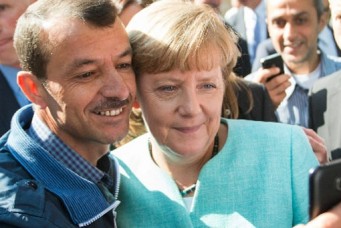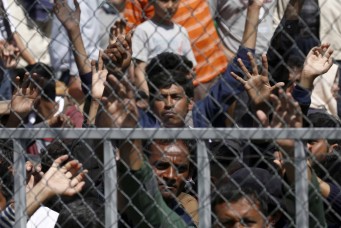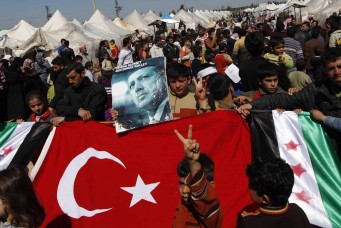In a Storm Not of their Making
The arrival of mass numbers of Syrian refugees in Europe has ignited a “perfect storm” for the surge of xenophobia and populist politics among Europeans. Its cause, however, originates in the West and not with the Syrians themselves.

A Syrian refugee woman cries as she arrives on the Greek island of Lesbos, Nov. 10, 2015. Alkis Konstantinidis/Reuters
The influx of Syrian refugees into Europe, an initial trickle after 2011 and then accelerating in 2015 and 2016, has appeared to have changed the political landscape of the continent. However, the reality is that the Syrians and hundreds of thousands of others from Sub-Saharan Africa to Afghanistan to the Maghreb have played into European nativist and populist narratives, rather than create them. Indeed, the growing power of populist parties in Europe has been branded by the Institute for Global Change as the single most significant transformation of European politics since the end of the Cold War.
Fear of refugees and migrants played a prominent role in the Brexit referendum as it did in the 2016 U.S. elections, setting the stage for electoral victories that were unthinkable a few years ago. While the nativist trend was held at bay in the Dutch, French, and German elections, Austria saw the rightwing Freedom party join a ruling coalition in December 2017; in the Italian 2018 elections the far-right League and the Five Star Movement took 50 percent of the vote, establishing a government in June 2018. Central and Eastern Europe have also seen their share of populist movements with populist parties taking power in Hungary and Poland.
The social and political changes that led to surges by populist parties are much older than the Syrian refugee influx into Europe. These changes range widely from the impacts of globalization and the loss of jobs to foreigners, to feelings of political disempowerment as unelected technocrats from Brussels and national capitals seemed to gain power while Europe’s established mainstream political parties prove unequal to the challenges of globalization. In fact, we can start to see that the populist wave began to rise well over a decade ago, exacerbated by the 2008 economic crisis and Europeans’ and Americans’ alienation from a political discourse which featured multiculturalism and questioned traditional gender norms. However, the currents of the populist wave were even older, going back decades. As such, the arrival of the Syrians in Europe turned a rising populist wave into a fierce storm, one that has now blown over the halls of power in London and Washington.
The Syrians, then, played an important but certainly not a determining role in a European crisis that long predated their arrival. Mostly Syrian refugees became fodder for an exaggerated and dangerous narrative in Europe of an existential, civilizational struggle, especially (but not exclusively) with Muslim migrants who were often the target of increasingly aggressive rhetoric and, occasionally, physical violence as this minority played the much-needed “other” in the populist/nativist narrative.
The Flow of the Displaced to Europe
Syria’s forcibly displaced represent the largest such phenomenon since the Second World War. As of spring 2018, there were nearly 5.7 million registered Syrian refugees, of which 3.6 million were in Turkey, nearly a million in Lebanon, some 660,000 in Jordan, 250,000 in Iraq, 128,000 in Egypt and 34,000 in the Maghreb. The total number of Syrian asylum seekers and refugees in Europe is one million. Syrians who are Internally Displaced Persons (IDPs) number well over 6 million. Overall, some 13.3 million Syrians out of a prewar population of 22 million have been forcibly displaced.
The flow of Syrians into Europe started as early as 2011 when Syria erupted in protests and civil war. As the West largely abstained from the fighting and providing meaningful support to more secular rebel groups, radical Islamist factions took over much of the uprising. The latter development would impact Europe’s sense of vulnerability as around 5,000 EU citizens, a tiny percentage of the over 26 million Muslims living in Europe, left to fight for the Jihadi cause in Syria.
From the European perspective, the Libyan uprising also added to the continent’s migrant and refugee challenge. It is instructive to note that the first migrant boats from Libya to Italy started years earlier, around 2005, including one of the first seaborne disasters in 2007 when a boat with fifty-seven immigrants went missing. Those numbers, reflecting political and economic challenges in various sub-Saharan countries, would also start to grow as the Libyan regime—which had an agreement with the EU to stem Europe-bound migrants—was overthrown and the country splintered.
The Syrian refugee influx increased after 2012 just as the flow from Libya also grew. Total asylum applications in Europe remained relatively steady at 20,000–30,000 a month from 2008 to 2012, then exceeded 40,000 a month in 2013 and reached 70,000 a month in 2014. At the end of 2015 when the massive spike occurred, some 1.3 million asylum claims were recorded in the EU, 400,000 or so from Syrians while the total number of people arriving in Europe that year was at over 1,800,000. By the end of 2016 a further 1.2 million people had applied for asylum in Europe.
Arrivals have been declining ever since. In the first quarter of 2018 a total of 18,000 asylum seekers arrived on European shores, less than half the number arriving in 2017 and a far cry from 2016’s 175,000. No Syrians were reported among the top ten sender countries via the Libya route, and those arriving via the Aegean Sea from Turkey were a trickle of the numbers arriving in 2015–16. This dramatic slowdown is in part due to an EU agreement with Turkey but also to many Balkan and Central European countries closing the route to West Europe via strict enforcement of their borders, with military forces deployed and walls and barriers built. Similarly, the sea route via Libya has also been largely blocked as Italy and the EU reached deals with the Tripoli government, various militias and several migrant-sending African countries.
Yet, with the war raging in Syria, well over two million IDPs in rebel-controlled areas like Syria’s Idlib province—with more elsewhere—and IDP movements within Syria continuing, further refugee flows are not out of the question. The even more frightening risk of an Israeli–Iranian confrontation potentially encompassing Lebanon, Syria, and beyond means that the danger of larger movements of populations within countries—as well as into neighboring countries and from there into Europe—cannot be discounted.
Leaving these dire scenarios aside, however, for now Europe’s so-called Syrian refugee crisis is over as far as the flow is concerned. The challenge now facing the newly arrived refugees is that of integration, which remains unresolved for significant parts of the earlier Muslim migrant communities in Europe.
Liberalism’s Crisis and the Perfect Storm
The “perfect storm” is an oft-used term when it comes to defining the surge in populist politics in Europe. Rogers Brubaker, professor of sociology at University of California, Los Angeles, points to causative trends that have been evolving over decades including the weakening of parties and party systems, and changing relations between the media and politics. As parties weaken, political leaders have become more inclined to directly address voters, facilitated by pervasive social media applications. There were also demographic, economic, and cultural changes which joined to create this confluence of events referred to as the perfect storm for populism.
One glaring issue resonated with populist constituencies across Europe. This was the permanent presence of resident migrants since the 1950s and 1960s, many of whom are Muslim, in many European cities. These migrants had been expected to return home after their work visas had finished. Yet many of them stayed in Europe and chose to make lives in wealthy cities and towns. While most adapted well, integration proved challenging for some and after their initial welcome to Europe to help rebuild after the Second World War, locals began to accuse the migrants of abusing welfare and stealing jobs. Almost inevitably, migrants were conveniently placed in the role of the “other” needed by nativist/populist politicians to galvanize votes.
This process of othering accelerated once globalization hit in full force in the 1980s and 1990s, leading to ever-greater income inequalities, the collapse of manufacturing jobs and flows of goods, services, investments and—of course—labor across borders. Protecting native laborers, goods, and services in a new nationalistic narrative was easy for the populists to adopt. This was especially so given the rightward and liberal drift among social-democratic parties at the end of the twentieth century prompting them to appeal to the center as their working-class base diminished, meaning that these parties were unable to take on new challenges and channel them in a more benign direction. Yet, there have always been limits to how far right and populist constituencies will vote given past experience with fascist regimes. Consequently, the examples of Greece and to a lesser extent in Spain and Portugal, in light of the relatively recent experience of Francoism, reflected the limited extent to which populist parties in recent decades have been able to gain a foothold in elections.
There has also been a cultural element to the confluence of the “perfect storm” as the multiculturalism and focus on minority rights of the left and liberal parties have attracted opposition from populists. These populists have defended “traditional” roles of families and women and targeted minority and LGBTQ rights, stating that a focus on minorities and transformative gender ideas has caused the degeneration in the West. The 2008 global economic crisis and the subsequent economic recession played a role as did the aloof and seemingly unaccountable and opaque workings of the EU itself and, of course, its narrative of open borders and inclusivity. The economic, political, and cultural changes that brought about populist movements are deep-seated and unlikely to change in the next few years.
The Challenge of Integration
It was into this changing and volatile landscape that the Syrian refugees and the other displaced peoples arrived in Europe, accompanied by a media blitz showing endless processions of refugees trudging through the Balkans or floundering in boats either in the Mediterranean or the Aegean seas. There were elections brewing in many countries and a growing terrorist threat symbolized by ISIS with the media focusing on various atrocities in Syria, Iraq, Libya, terrorist attacks in London, Brussels, Paris, Nice, as well as smaller but well-covered attacks in Copenhagen, Oslo, Berlin, and elsewhere.
Chancellor Angela Merkel’s initial invitation to the refugees provided an immediate target for populists in Germany as the Alternative for Germany party emerged as a reaction against the influx and Merkel’s welcoming approach—she too would harden her stance as the elections approached. Sweden, which had accepted more asylum seekers on a per-capita basis than Germany, also saw a surge of support for the Sweden Democrats, a party which had been trying to shed its extreme right views. Already receiving some 13 percent of the vote in 2014, only three years after first entering parliament in 2011—long before the influx in asylum seekers—the Sweden Democrats are currently polling around 20 percent as the September 2018 elections approach.
In both Germany and Sweden, the surge in support for populist parties can probably be most directly linked to the fears around refugees and their perceived rather than actual impacts on crime and/or terrorism. Numerous studies in Germany and elsewhere show that refugees are less prone to criminality than local populations of the same income and demographics. As for fears of terror, by far the majority of terrorist acts have been carried out by Muslim citizens or residents of European countries who are almost always born in these countries and are the second or even older generations of their families.
The challenge the Muslim population poses in this new Europe is undoubtedly exacerbated by terrorism, but predates such atrocities and points to deeper conflicts around integration in European societies. This challenge of fuller integration is made all the more pressing given that Muslim population numbers are set to increase significantly. Using data from the Pew Research Center, given low immigration rates, there will be 36 million Muslims in Europe by 2050, accounting for 7.4 percent of the total population versus roughly 5 percent today. In an unlikely high immigration scenario, the number of Muslims could increase more to 76 million or 14 percent of the population. In a more realistic, medium migration scenario, the respective numbers are set to be 58 million and 12.6 percent of the European population by 2050.
Even in a scenario where there is zero migration to Europe, 11 percent of Belgium’s, 10 percent of Sweden’s, nearly 10 percent of the UK’s, 9 percent of Germany’s, and 13 percent of France’s populations are set to be Muslim by 2050. The realities of these numbers mean that continued anti-immigrant and anti-Muslim narratives promise a future of greater turmoil and social tensions in the West. This need not be the case, however, especially since an aging Europe will need more, not less, immigration. It is also worth noting that most European Muslims identify strongly with their host countries. When asked, 96 percent of Muslims in Germany and France feel that they were connected to their host countries. That figure is 98 percent in Switzerland and 89 percent in the UK. Yet growing anti-Muslim rhetoric and increasing aggressiveness could threaten their sense of identity.
The rapidity with which even Eastern Europeans found themselves targeted in places like Britain once the populist wave took over underlines that even broader narratives around a European identity are vulnerable to narrow nationalisms. While Brexit figures heavily in anti-Eastern European narratives, “No Eastern Europeans” signs first appeared in the UK in 2013, well before the Brexit vote in 2016. Worth noting is that the infamous “polish plumber” character is not a British invention but a French one and its symbolism played an important role in the French “no” vote in the European Constitutional referendum of 2005. A spike in Serbians in German jails in 2018 underlines the potential for further problems in this arena. Once the genie of nativism is unleashed it is indeed hard to restrain.
Furthermore, the populists’ economic nationalism is a double-edged sword as it risks igniting a global trade war while seeking to protect local populations from the real and perceived dangers of economic displacement. Worse, nativist economic policies could lead to a global depression creating a situation uncomfortably reminiscent of the 1930s when nativist politics—foremost in Italy and Germany but not there alone—set the world on fire.
As to the Syrian influx and the broader flow of migrants in the 2014–16 period, the new arrivals served as fodder for, but did not create, the basis for the nationalist, populist reaction to the post-Second World War liberal era. What is clear is that unless that nationalist–populist reaction is contained with a renewed narrative emphasizing more inclusive values, we could be in for decades of turmoil in Europe and the United States—in short, decades of turmoil at the very core of the global economy.
Omer Karasapan is a Senior Operations Officer at the World Bank. He blogs regularly at the Brookings Institution and the World Bank, mostly on the Middle East with a focus on refugee issues.





